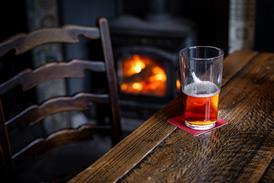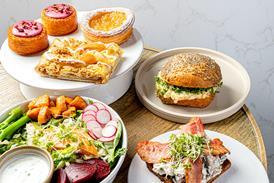Mike Williams, director at UK food safety consultancy STS, explains the three fundamental areas an environmental health officer will look at during an inspection and how getting these areas right means food businesses will have little trouble achieving a 5* food-hygiene rating:
Confidence in management
As well as operator competency, environmental health officers gives careful consideration to documented food safety management systems (HACCP), record keeping and the general approach to food safety demonstrated during inspection.
A properly documented food safety management system will fully reflect the processes followed in a kitchen, identifying any hazards and the requisite controls in place to ensure the hazard does not affect the food served. Some of these controls will be classed as critical (CCPs) and are usually the ones that are monitored – eg, fridge storage temperatures or the end cook temperatures of foods. Your EHO will look to see whether you have identified the CCPs and that you have put in place and are maintaining suitable records to demonstrate daily control. Remember – these records must reflect what’s going on in the kitchen.
Your EHO will also look at how well trained your staff are. Food-hygiene training is essential in any food business and the Level 2 Award in Food Safety is the accepted standard. However times are changing and EHO’s are not just looking for certificates; they want to see staff demonstrate their understanding of food safety and, more specifically, the food-safety controls detailed in your food safety management system. If you get training right then your food standards will be better, and your EHO will recognise this.
Management record keeping is more than just temperatures and training certificates; due diligence allows a business to demonstrate they are doing all they can to maintain food safety. Proving suitable opening and closing checks are conducted daily is a good way of showing that activities such as stock rotation have taken place, suitable supplies of cleaning chemicals are available and hand wash basins are suitably stocked. If your EHO sees that your activities are backed up by good record keeping then you will invariably score well in this section.
Structural condition (including cleaning)
If you make sure that basic structural surfaces, walls, floors and ceiling are finished to a good standard, all equipment is suit-
able to the operation and in good condition, then you’re off to a good start! Remember – equipment needs servicing and it’s important to be able to prove you have plans in place for upkeep. Don’t wait for your EHO to ask, if you have processes in place, be sure to tell them.
Cleaning is a rather obvious aspect of food safety and the easiest for an EHO to identify when businesses get it wrong. Accurate cleaning schedules help improve and maintain your standards; a good schedule will identify all cleaning tasks, frequency and what equipment/chemicals should be used. It’s really good practice to ensure the person completing each task signs to say they’ve cleaned then a supervisor should verify. Successful businesses only allow a supervisor to sign off the schedule as completed once they’re happy that cleaning standards are suitable.
It’s essential to ensure you have the right tools to clean your kitchen. At the minimum, you should always have detergent, sanitisers, antibacterial soap and heavier cleaning chemicals – eg, a degreaser – available. Sanitisers must be made up and ready to use before food preparation starts and it’s important to check that they conform to BS EN 1276 as your EHOs will look for this. You also need to ensure you have suitable cloths, mops and buckets. Remember – cleaning equipment should be kept clean at all times so rinse out mop heads and buckets after each use and never leave a mop in dirty water.
Hygiene standards
This takes into account elements including cross-contamination control, personal hygiene standards and temperature control, commonly demonstrated by practical and physical implementation of your foodsafety management system procedures.
Controlling cross-contamination requires some thought. There are some basic areas – eg, ensuring raw meat and fish are always stored below or separately from ready-to-eat foods, or using colour-coded chopping boards. But cross-contamination control also means ensuring you take steps to avoid contaminating foods with any of the 14 known allergens. Remember – allergen advice needs to be available to all your customers and you must never guess at the content of foods!
Maintaining temperature control during storage, cooking/reheating, cooling and service is of vital importance. If you can prove that you know your temperature targets, have the right tools – eg, working probe thermometer and antibacterial probe wipes, and keep thorough records of temperatures, then you are compliant.
EHOs also look at food cooling with increased detail. It’s essential to ensure you cool food as quickly as possible, although there’s a common misconception that you only have 90 minutes in which to cool food to below 8°C. That is the case with blast chillers but if you’re manually cooling food with ice baths or walk-in fridges, then you actually have up to four hours. This doesn’t mean take four hours every time; you should take as many steps as possible to ensure that food is cooled quickly. Cutting food into smaller portions, placing liquids into shallow containers and placing food on ice baths or in cold areas of the kitchen are all good practices to speed up cooling. Check and keep records to demonstrate this, in line with your other records.
Personal hygiene is hugely important for maintaining food safety. EHOs will always be looking to see whether staff wash their hands, and how. Ensuring proper hand washing should be part of any food handler’s induction training, but regular checking and refresher training helps. It goes without saying that hand wash basins have running hot and cold water and are stocked with antibacterial soap and paper towels.
Finally, it’s critical to ensure your premises are pest free; the majority of prosecutions carried out by EHOs are pest related. It’s not difficult to keep your food business free from rodents and insects. A basic control is ensuring that they cannot get in in the first place and keeping your kitchen clean won’t just satisfy your EHO – it will ensure pests have nothing to eat. It’s good practice to appoint a recognised pest controller to monitor conditions in your kitchens and stores; they should visit about eight times a year and be available for emergency call outs if unwelcome intruders are spotted.
Keeping contamination controls in place, looking after personal hygiene standards, keeping your premises pest free and en-suring that all your temperature controls are in place will keep your food safe and your EHO happy.
■ STS is a provider of food safety consultancy and training services to caterers, food retailers and suppliers in the hospitality, healthcare and education sectors.





































